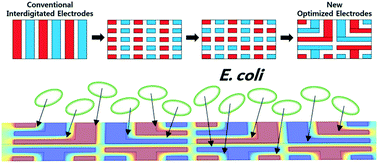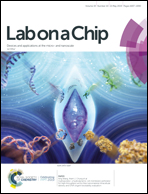Two-dimensional computational method for generating planar electrode patterns with enhanced volumetric electric fields and its application to continuous dielectrophoretic bacterial capture†
Abstract
An array of microfabricated interdigitated electrodes (IDEs) is one of the most commonly used forms of electrode geometry for dielectrophoretic manipulation of biological particles in microfluidic biochips owing to simplicity of fabrication and ease of analysis. However, the dielectrophoretic force dramatically reduces as the distance from the electrode surface increases; therefore, the effective region is usually close to the electrode surface for a given electric potential difference. Here, we present a novel two-dimensional computational method for generating planar electrode patterns with enhanced volumetric electric fields, which we call the “microelectrode discretization (MED)” method. It involves discretization and reconstruction of planar electrodes followed by selection of the electrode pattern that maximizes a novel objective function, factor S, which is determined by the electric potentials on the electrode surface alone. In this study, IDEs were used as test planar electrodes. Two arrays of IDEs and respective MED-optimized electrodes were implemented in microfluidic devices for the selective capture of Escherichia coli against 1 μm-diameter polystyrene beads, and we experimentally observed that 1.4 to 35.8 times more bacteria were captured using the MED-optimized electrodes than the IDEs (p < 0.0016), with a bacterial purity against the beads of more than 99.8%. This simple design method offered simplicity of fabrication, highly enhanced electric field, and uniformity of particle capture, and can be used for many dielectrophoresis-based sensors and microfluidic systems.



 Please wait while we load your content...
Please wait while we load your content...